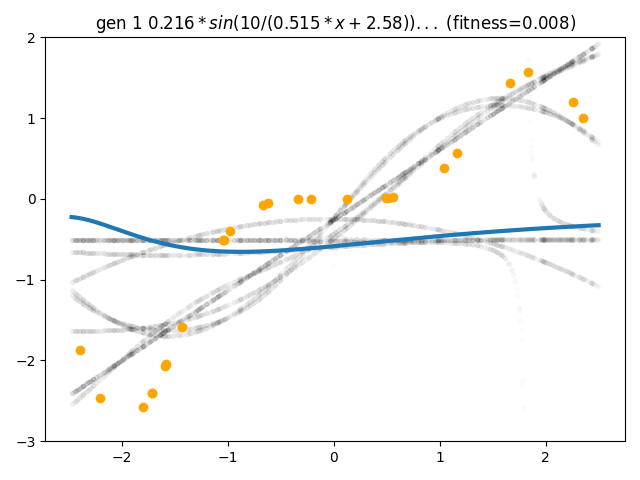genepro
Art of a juniper, "ginepro" in Italian, made with the genetic drawing repo by @anopara.In brief
genepro is a Python library providing a baseline implementation of genetic programming, an evolutionary algorithm specialized to evolve programs.
This library includes a classifier and regressor that are compatible with scitik-learn (see examples of usage below).
Evolving programs are represented as trees. The leaf nodes (also called terminals) of such trees represent some form of input, e.g., a feature for classification or regression, or a type of environmental observation for reinforcement learning. The internal nodes represent possible atomic instructions, e.g., summation, subtraction, multiplication, division, but also if-then-else or similar programming constructs.
Genetic programming operates on a population of trees, typically initialized at random. Every iteration (called generation), promising trees undergo random modifications (e.g., forms of crossover, mutation, and tuning) that result in a population of offspring trees. This new population is then used for the next generation.
Example of 1D symbolic regression (made with this gist)Installation
For classification or regression, genepro relies only on a few libraries (numpy, joblib, and scikit-learn).
However, additional libraries (e.g., gym) are required to run the reinforcement learning example.
Thus, you can choose to perform a minimal or full installation.
Minimal installation
To perform a minimal installation, run:
pip install genepro
Full installation
For a full installation, clone this repo locally, and make use of the file requirements.txt, as follows:
git clone https://github.com/marcovirgolin/genepro
cd genepro
pip install -r requirements.txt .
Wish to use conda?
A conda virtual enviroment can easily be set up with:
git clone https://github.com/marcovirgolin/genepro
cd genepro
conda env create
conda activate genepro
pip install .
Examples of usage
Classification and regression
The notebook classification and regression.ipynb shows how to use genepro for classification and regression, via scikit-learn estimators.
These estimators are intended for data sets with a small number of (relevant) features, as the evolved program can be written as a compact (and potentially interpretable) symbolic expression.
...
gen: 39, best of gen fitness: -2952.999, best of gen size: 46
gen: 40, best of gen fitness: -2950.453, best of gen size: 44
The mean squared error on the test set is 2964.646 (respective R^2 score is 0.512)
Obtained by the (simplified) model: 146.527 + -5.797*(-x_2**2 - 4*x_2 - 3*x_3 + 2*x_4 - x_5 - x_6*(x_4 - x_5) + x_6 - 5*x_8)
Example of output of a symbolic regression model discovered for the Diabetes data set.
Reinforcement learning
The notebook gym.ipynb shows how genepro can be used to evolve a controller for the CartPole-v1 environment of the OpenAI gym library.
(x2 + x3) * (x2*x3 + x3 + x4 + 1) * log(abs(x2))^2 * log(abs(x3))^2 < 0.5? 'left' else 'right'
Citation
If you use this software, please cite it with:
@software{Virgolin_genepro_2022,
author = {Virgolin, Marco},
month = {9},
title = {{genepro}},
url = {https://github.com/marcovirgolin/genepro},
version = {0.1.0},
year = {2022}
}


